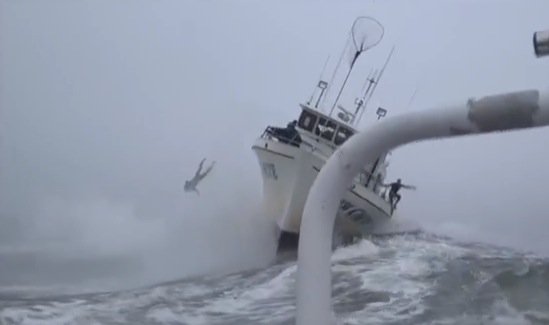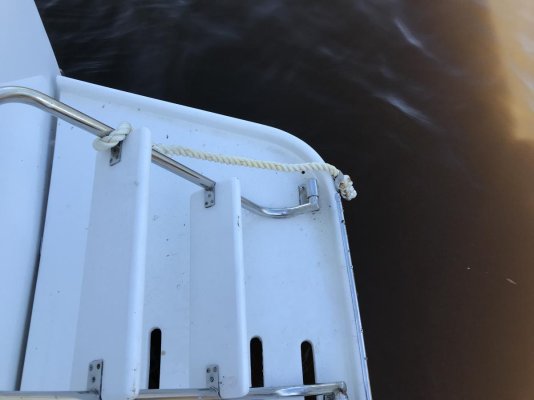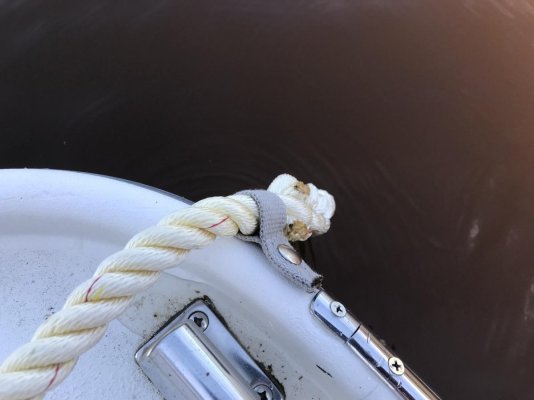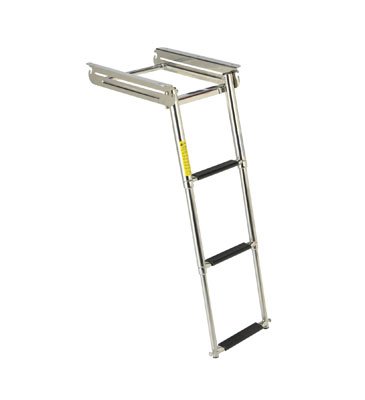Knot Fast
Senior Member
- Joined
- Jan 22, 2018
- Messages
- 243
- Location
- United States
- Vessel Name
- Knot Fast
- Vessel Make
- Great Harbour GH37
Man Over Board
It was a quiet Saturday night in the Marina. Then a neighbor’s Sea Ray (why always a Sea Ray?) returned to their slip in high (10 gust 20 knot) winds. The Sea Ray banged into his adjacent neighbor and took 10 minutes to secure the first 3 lines because it was dark and they were unprepared. I tried to assist, but the Sea Ray owner seemed very stoic and non-communicative. When 3 lines were secured, I returned to my boat. The adjacent neighbor asked for the Sea Ray’s insurance info…
About 30 minutes later I heard a splash. At first I thought, “…now these guys have dropped something in the water…”. A minute later it occurred to me that with those guys, it could be anything, so I go back on the dock to investigate. I find two 40 yo guys (the “Friends”, one is the Sea Ray owner) on the Sea Ray swim platform, trying to pull another guy (the “Big Guy”) out of the water. Big Guy had fallen in while moving from the boat to the pier. I watched their recovery efforts for about 30 seconds and realized something was wrong – none of them were talking and none of them were moving. The swim platform had a ladder but it was covered with toys lashed to the platform and could not be deployed. The toys made the footing bad for the friends. There was no room on the platform. The Friends where fully bent over and each had one of Big Guy’s arms; Big Guy’s head was above the water. I grabbed a life ring with rope and tossed it next to Big Guy in the water; I asked “what can I do to help”. A Friend on the swim platform said to Big Guy “come on man, kick, you’re really heavy”. No answer from Big Guy. Still, no body was moving – it was like a frozen callisthenic exercise. At about the 120 second mark of my arrival I switched to action mode and started yelling loud “Help!, Help!, Help!” And just kept yelling until neighbors started showing up. Another neighbor and I laid down on the finger pier and grabbed the big guy’s belt and pulled him more out of the water while his friends pulled him onto the swim platform. That worked! It turned out Big Guy weighed about 270# and was super-fit. Think football player…
At this point, about 10 neighbors were on the dock. The Friends assisted Big Guy onto the finger pier and he collapsed and almost went in to the water again. Big Guy could not stand; he crawled with assistance from the finger to the main dock where he tried to stand and fell down. He was too large and too slippery to properly assist. At that point I took over. I said keep him down on the dock so he does not fall. And I called 911. Though the “Friends” said “he’s ok”, my neighbors immediately formed a chorus of “keep him down on the dock” while I made the call. Neighbors brought Big Guy a blanket and pillow. One neighbor noted he was rubbing his head a lot and suggested he may have hit it on entering the water. Big Guy repeatedly tried to get up but could not. When paramedics arrived, Big Guy could not state his name and said the year was 2020. The paramedics pronounced him very drunk and transported him to the hospital.
Lessons learned:
1. (obvious) don’t drink and boat
2. Anyone could slip, hit their head, fall into the water, and be unable to get out under their own power
3. It is VERY DIFFICULT to pull someone out of the water. It took 4 guys to pull ~270#, so maybe 70#/per guy. Most women can pull less.
I plan to install a Lifesling to add to our safety equipment. My boat has a dinghy crane who’s top is 15’ above the water line and seems well situated for use with Lifesling. Anyone have experience with a better product? [I read the thread "Anyone have a Lifesling?"] When gf and I cruise, we will practice using it for each of us (in warm calm water).
Be careful out there…
It was a quiet Saturday night in the Marina. Then a neighbor’s Sea Ray (why always a Sea Ray?) returned to their slip in high (10 gust 20 knot) winds. The Sea Ray banged into his adjacent neighbor and took 10 minutes to secure the first 3 lines because it was dark and they were unprepared. I tried to assist, but the Sea Ray owner seemed very stoic and non-communicative. When 3 lines were secured, I returned to my boat. The adjacent neighbor asked for the Sea Ray’s insurance info…
About 30 minutes later I heard a splash. At first I thought, “…now these guys have dropped something in the water…”. A minute later it occurred to me that with those guys, it could be anything, so I go back on the dock to investigate. I find two 40 yo guys (the “Friends”, one is the Sea Ray owner) on the Sea Ray swim platform, trying to pull another guy (the “Big Guy”) out of the water. Big Guy had fallen in while moving from the boat to the pier. I watched their recovery efforts for about 30 seconds and realized something was wrong – none of them were talking and none of them were moving. The swim platform had a ladder but it was covered with toys lashed to the platform and could not be deployed. The toys made the footing bad for the friends. There was no room on the platform. The Friends where fully bent over and each had one of Big Guy’s arms; Big Guy’s head was above the water. I grabbed a life ring with rope and tossed it next to Big Guy in the water; I asked “what can I do to help”. A Friend on the swim platform said to Big Guy “come on man, kick, you’re really heavy”. No answer from Big Guy. Still, no body was moving – it was like a frozen callisthenic exercise. At about the 120 second mark of my arrival I switched to action mode and started yelling loud “Help!, Help!, Help!” And just kept yelling until neighbors started showing up. Another neighbor and I laid down on the finger pier and grabbed the big guy’s belt and pulled him more out of the water while his friends pulled him onto the swim platform. That worked! It turned out Big Guy weighed about 270# and was super-fit. Think football player…
At this point, about 10 neighbors were on the dock. The Friends assisted Big Guy onto the finger pier and he collapsed and almost went in to the water again. Big Guy could not stand; he crawled with assistance from the finger to the main dock where he tried to stand and fell down. He was too large and too slippery to properly assist. At that point I took over. I said keep him down on the dock so he does not fall. And I called 911. Though the “Friends” said “he’s ok”, my neighbors immediately formed a chorus of “keep him down on the dock” while I made the call. Neighbors brought Big Guy a blanket and pillow. One neighbor noted he was rubbing his head a lot and suggested he may have hit it on entering the water. Big Guy repeatedly tried to get up but could not. When paramedics arrived, Big Guy could not state his name and said the year was 2020. The paramedics pronounced him very drunk and transported him to the hospital.
Lessons learned:
1. (obvious) don’t drink and boat
2. Anyone could slip, hit their head, fall into the water, and be unable to get out under their own power
3. It is VERY DIFFICULT to pull someone out of the water. It took 4 guys to pull ~270#, so maybe 70#/per guy. Most women can pull less.
A. I probably cannot pull my beloved, light-weight girlfriend out of the water (though I would probably die trying…)
B. There is no chance gf can pull me out of the water
C. A. & B. are unacceptable
4. Keep you swim platform clear and your ladder deployable from the water B. There is no chance gf can pull me out of the water
C. A. & B. are unacceptable
I plan to install a Lifesling to add to our safety equipment. My boat has a dinghy crane who’s top is 15’ above the water line and seems well situated for use with Lifesling. Anyone have experience with a better product? [I read the thread "Anyone have a Lifesling?"] When gf and I cruise, we will practice using it for each of us (in warm calm water).
Be careful out there…







